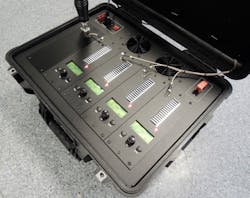Remotely controlled and detonated explosives are a concern not just on the battlefield, but also in airports and public places. To combat the growing threat of wirelessly detonated explosives, HSS Development, Inc. has unveiled its modular Bomb Jammer technology, which allows military and law enforcement to switch among five different RF modules to cover a total available frequency jamming range from 20 to 6,000 MHz. Operators control the amount of jamming power transmitted by the system, with total radiated output power as high as 150 W; each module produces as much as 30 W output power.
The MJ-5 Bomb Jammer (see photo) allows users in the field to choose which frequencies they want to jam, quickly and easily. Frequency ranges are built into four modules, with the fifth left open for scalable and custom requirements. The system is designed and built for frequency coverage depending upon a user’s needs. The total power of the five modules can be directed in an electromagnetic (EM) wave that is powerful enough to block a selected frequency range without any degradation of the jamming signal.
For standard VHF through UHF frequency ranges, the system is equipped with communications windows which can be programmed or allocated by an MJ-5 operator if needed. The windows remain stable and open due to the use of a proprietary hybrid combination of direct-digital-synthesis (DDS) and phase-lock-loop (PLL) technologies to generate the jamming signals in the MJ-5. The frequency ranges of modules include 25 to 500 MHz, 800 to 1,000 MHz, 1,800 to 2,000 MHz, and 2,110 to 2,170 MHz, with the five modules covering a custom frequency range. The Bomb Jammer works with external directional or omnidirectional antennas and is powered by 90 to 240 V ac or 10 to 15 V dc.


